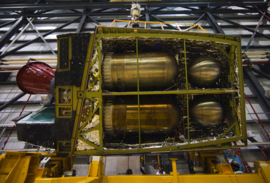Orbital maneuvering system

The underside of a left OMS/RCS pod.
|
|
| Manufacturer | Aerojet |
|---|---|
| Country of origin | United States |
| Used on | Space Shuttle |
| General characteristics | |
| Diameter | {{{diameter}}} |
| Length | 21.8 feet (6.6 m) |
| Width | 11.37 feet (3.47 m) (aft) 8.14 feet (2.48 m) (forward) |
| Launch history | |
| Status | Retired |
| Total launches | 135 |
| Successes (stage only) |
134 |
| Lower stage failed |
1 (STS-51-L) |
| First flight | STS-1 (12 April 1981) |
| Last flight | STS-135 (8 July 2011) |
| OMS Engine | |
| Engines | 1 AJ10-190 |
| Thrust | 26.7 kilonewtons (6,000 lbf) |
| Specific impulse | 316 seconds (vacuum) |
| Burn time | 15 hours (maximum service life) 1250 seconds (deorbit burn) 150–250 seconds (typical burn) |
| Fuel | MMH/N2O4 |
| Aft Primary RCS | |
| Engines | Primary RCS engines |
| Thrust | 3.87 kilonewtons (870 lbf) |
| Burn time | 1–150 seconds (each burn) 800 seconds (total) |
| Fuel | MMH/N2O4 |
| Aft Vernier RCS | |
| Engines | Vernier RCS engines |
| Thrust | 106 newtons (24 lbf) |
| Burn time | 1–125 seconds (each burn) |
| Fuel | MMH/N2O4 |
The Space Shuttle Orbital Maneuvering System (OMS), is a system of hypergolic liquid-propellant rocket engines used on the Space Shuttle. Designed and manufactured in the United States by Aerojet, the system was used during launch to produce supplementary thrust and on-orbit to provide orbital injection, orbital correction and the spacecraft's deorbit burn. The OMS consists of two pods mounted on the Orbiter's aft fuselage, on either side of the vertical stabilizer. Each pod contains a single AJ10-190 engine, based on the Apollo Service Module's Service Propulsion System engine, which produces 26.7 kilonewtons (6,000 lbf) of thrust with a specific impulse (Isp) of 316 seconds. Each engine could be reused for 100 missions and was capable of a total of 1,000 starts and 15 hours of burn time.
These pods also contained the Orbiter's aft set of reaction control system (RCS) engines, and so were referred to as OMS/RCS pods. The OM engine and RCS systems both burned monomethylhydrazine (MMH) as fuel, which was oxidized with dinitrogen tetroxide (N2O4), with the propellants being stored in tanks within the OMS/RCS pod, alongside other fuel and engine management systems. When full, the pods together carried around 8,174 kilograms (18,021 lb) of MMH and 13,486 kilograms (29,732 lb) of N2O4, allowing the OMS to produce a total of around 1,000 feet per second (300 m/s) of delta-v with a 65,000-pound (29,500 kg) payload.
OMS/RCS pod schematic
An OMS pod detached from an Orbiter for maintenance
...
Wikipedia
